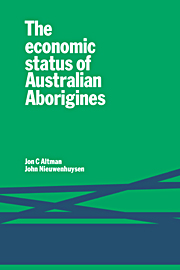Book contents
- Frontmatter
- Contents
- List of Tables
- List of Maps
- Preface
- Acknowledgements
- Abbreviations
- 1 Inequality: an overview
- 2 Remote Australia I: government settlements and missions
- 3 Remote Australia II: pastoral stations
- 4 Remote Australia III: decentralised communities
- 5 Settled Australia I: urban and rural communities
- 6 Settled Australia II: the major urban areas
- 7 Some economic issues
- Appendixes
- Bibliography
- Index
1 - Inequality: an overview
Published online by Cambridge University Press: 11 March 2010
- Frontmatter
- Contents
- List of Tables
- List of Maps
- Preface
- Acknowledgements
- Abbreviations
- 1 Inequality: an overview
- 2 Remote Australia I: government settlements and missions
- 3 Remote Australia II: pastoral stations
- 4 Remote Australia III: decentralised communities
- 5 Settled Australia I: urban and rural communities
- 6 Settled Australia II: the major urban areas
- 7 Some economic issues
- Appendixes
- Bibliography
- Index
Summary
The absence of reliable demographic data on the Aboriginal population of Australia reflects their unequal status in contemporary Australian society … Under the criteria applied until recently by Australian immigration authorities to screen potential settlers, most Aborigines would have been denied the right to settle in their own country: they are non-European, have few technologically useful skills, are often unemployed, suffer from malnutrition and sickness to such a degree that by age 40 many are unemployable, figure predominantly in crime statistics, and have a low reputation in the large society.
F. L. Jones, Racial and Ethnic Minorities: The Case of Aboriginal AustraliansWhat socio-economic differences are there between the Aboriginal population as a group and the remainder of Australian society? While most people in Australia could probably give some suggestion as to these differences, it is unlikely that there is any simple source to which someone interested in the question could turn to find a reasonable summary of the information necessary to make a useful comment. In this chapter, therefore, a synthesis is given of the available material on various aggregate socio-economic indicators. These assist a comparison of the standard of living of Aborigines as a group with that of the rest of the Australian population.
For this synthesis, it is not ‘primary’ material that has been collected: only the available ‘secondary’ information has been drawn together; and Aborigines as a general, internally undifferentiated group are discussed. In this grouping, the analysis is based upon an examination of the aggregate ‘Aboriginal population’ of Australia as at present ‘officially’ defined.
- Type
- Chapter
- Information
- The Economic Status of Australian Aborigines , pp. 1 - 21Publisher: Cambridge University PressPrint publication year: 1979

